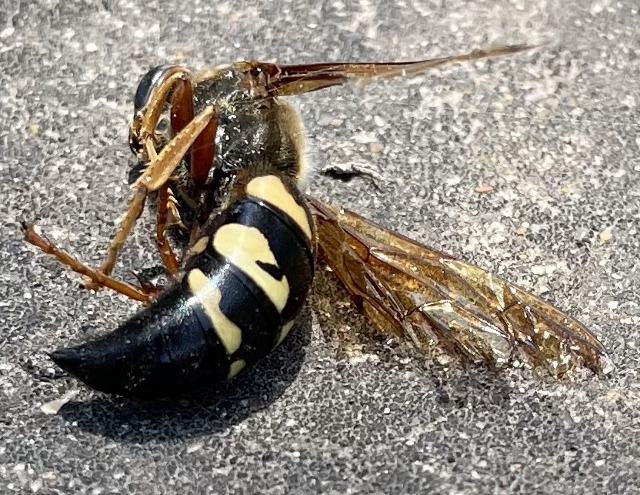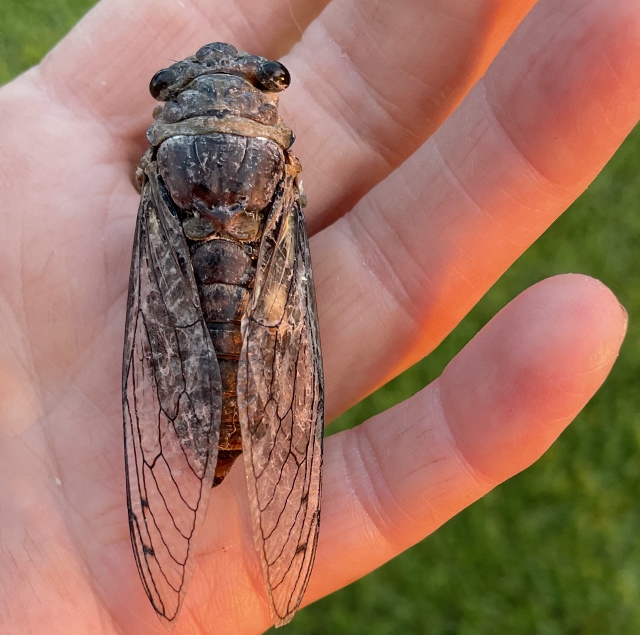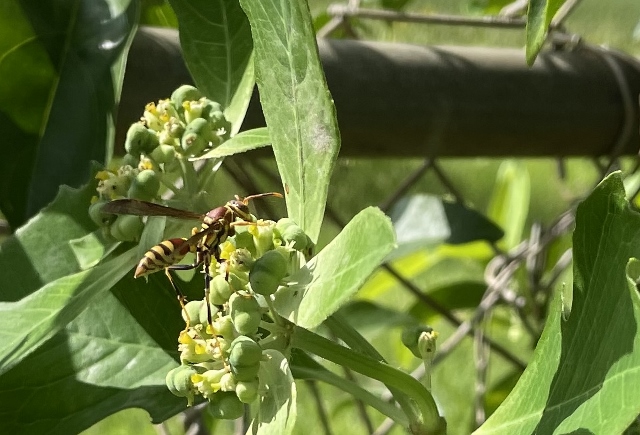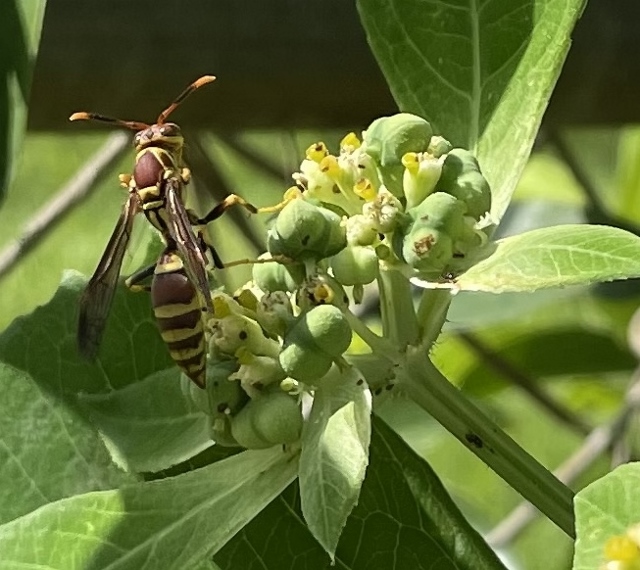This is the time of year I talk about my favorite insects –those noisy, siren-singing-sounds-of-summer cicadas.
I’ve heard very few this year, three, to be exact; their absence strikes a loud void in the pre-dawn air and cuts a deep pining in my soul for their illusive comfort of a carefree childhood when I was out of school, idle and curious.
During my early morning walk the other day, without the accompanying shriek of my lovely cicadas, I found something on the pavement at the end of the driveway; even in death it looked potent, big and deadly. iNaturalist quickly identified it as an Eastern cicada-killer wasp, Sphecius speciosus. I certainly wasn’t thrilled to discover the likes of it. I left it where it lay.

In another section of the yard, I spied a big, beautiful — and sadly — dead giant cicada, Quesada gigas.
The two incidents were not related, as you’ll see in a moment. At the time, though, I couldn’t help thinking that for every action there is an equal and opposite reaction — the cicada killer killed the cicada and then died; cause and effect; eye for an eye; and finally, just karma — what goes around comes around. And apparently, it wasn’t like that at all.

With a modicum of research, I found that female cicada-killer wasps hunt cicadas, stab them, and inject a venom that paralyzes the cicada, which allows the wasp to tote it back to the wasp’s subterranean den. The wasp wedges the full cicada down the hole, pokes it into a cell, lays eggs on it and then seals off that cell; the larva hatch in a couple of days, feed exclusively on the cicada and eventually form a cocoon to winter over. Often times the wasp struggles, carrying the cicada in flight as it may be twice her weight.
Cicada-killer wasps are about two inches in length, which makes them one of the largest wasps in Texas; certainly in competition with the tarantula hawk — at two inches in length, the tarantula hawk is noted as one of the five largest wasps in the world.
More on the tarantula hawk can be found at two previous blog posts: https://rgvctmn.org/blog/anitas-blog-interesting-visitor-to-zizotes-garden/ and https://rgvctmn.org/blog/anitas-blog-weavers-flyers-and-crawlers/
Cicada-killer wasps begin to appear in late July and early August; coincidentally, the singing of the annual cicadas causes the adult cicada-killer wasps to come above ground, out of hibernation. The adult wasps feed on flower nectar and water; larvae feed only on cicadas. The wasps are non-aggressive, for all their fear-inducing size and markings. The males are territorial, but they cannot sting. Females can, but only if handled or disturbed; they do not have the instinct to guard their nest, according to farmanddairy.com.
Some regard the cicada-killer wasps as beneficial because they are a natural control of the annual cicada populations. On the other hand, the giant wasp’s excavating and burrowing that they do in open, dry ground when constructing their nests can be a nuisance for proper-owners. In our case, the wasp excavated right in the middle of the courtyard’s pristine St. Augustine grass. When I found the wasp hole while I was mowing, I plopped a large potted plant on top of it. Before I’d found its hole and before I knew what it was, it was frightening having it fly around me in the small, confined area of our courtyard. It literally chased me out of the courtyard a couple of times. After the potted plant was placed on top of the hole, I suspected the wasp, if it were in residence at the time, would burrow out by creating an escape tunnel. As it happened, I spotted a wasp flying around for a couple of days and now appears to have moved on.
As I continued my rounds that day, I found another new-to-me wasp on a painted spurge, Euphorbia heterophylla, near the fence adjacent to the neighboring cotton field. The wasp was busy with the flowers, and I was already close, so I braved a couple of shots before making a speedy retreat. Again, iNaturalist.org identified it: Guinea paper wasp, Polistes exclamans, or common paper wasp.


Paper wasps prey on a wide variety of caterpillars, which they chew up and feed to the larvae in the nest; caterpillars include members of the owlet, tiger and sphinx moths. The wasps are beneficial; they pollinate flowers while seeking out nectar. They also eat a large number of insects, thereby helping to control populations of pest insects.
Since I have no new tales of cicadas so far this year, check out these two links from previous posts about these unique critters:
Jul 21, 2019, Superb Dog-day, https://rgvctmn.org/blog/anitas-blog-superb-dog-days/
July 16, 2020, Siren Song of Summer, https://rgvctmn.org/the-siren-song-summer/

Leave a Reply